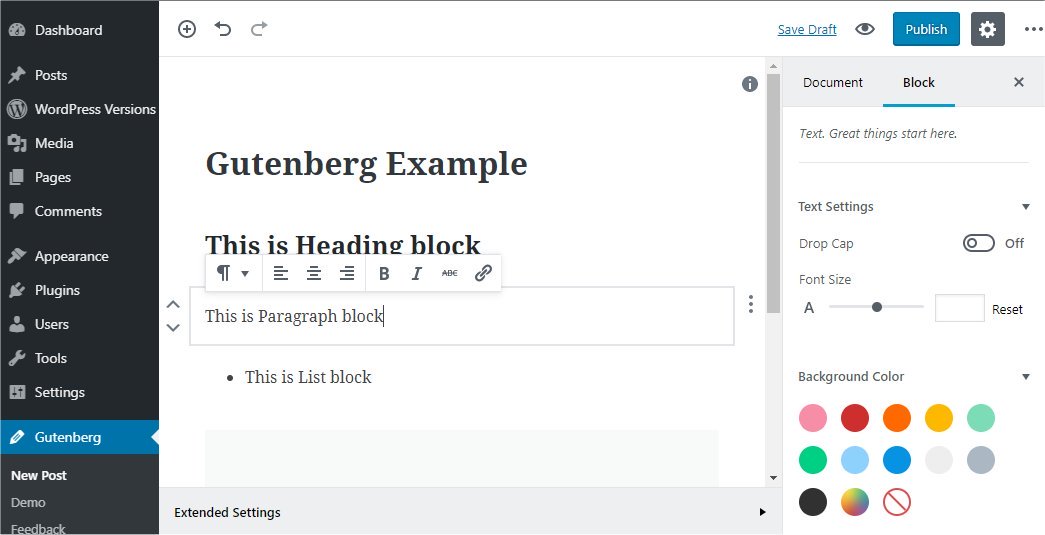With WordPress 5.0, various new features are being added. Among them is the addition of Gutenberg. Gutenberg is a new visual editor, replacing the WYSIWYG (“What You See is What You Get”) editor that exists on WordPress currently. Gutenberg has been set out to simplify content creation and make it so users do not need to know HTML or CSS. If everything goes well, website developers will be able to create visually-appealing webpages without the need of coding it from scratch. Right now, Gutenberg is being met with a mixed reception. Some are looking at Gutenberg positively, but others aren’t happy with the update.
The Pros
- Gutenberg is mobile-friendly, helping people who need to make edits when they may not have access to a tablet or laptop. Even with plugins that make it easy to customize pages, they do not provide cross-device compatibility.
- Rich content will be easier to add, including the ability to embed external links from 34 different websites. These include YouTube videos, Tweets, Facebook Posts, and more. All that needs to be done is to insert the URL of what you want to embed, and Gutenberg handles the rest.
- If a user ever wants to change the theme for their WordPress site, Gutenberg will prevent pages from breaking with the new theme. This is a support that current visual composers like Divi do not possess, as each one has content built into the themes that make it hard to change the look without destroying what the content looks like.
- The editor is focused on content and allows more screen space to see what the final product will look like. For users who are distracted by back-end functions or notices on the top of the page, it has a full-screen template that can hide anything that is not the content going onto the page.
The Cons
- Not everyone wants the blocks Gutenberg currently implements. The editor that exists on WordPress right now, TinyMCE, is more customizable than Gutenberg and allows developers to make one page appear many ways in the same format.
- Despite the interface being considerably more user-friendly and responsive, the columns have been left out of this responsive ability. As of right now, columns remain in their columns on smaller screens instead of stacking, making text harder to read and images harder to view. WordPress has confirmed this is a temporary issue, but this change will not be implemented until later.
- The minimalist design has led to many options being pushed to the settings bar on the side or hard to find. This has led to an increase in clicking to get the same thing done, such as needing to dig into the options on the side for changing the header size or updating a paragraph’s styling. Updating a page has many stops along the way as well, with prompts for visibility, publish date, drafts, before the option to update the page finally appears.
- Compatibility can be an issue once Gutenberg is implemented. WordPress has thousands of plugins and themes complete a variety of tasks on WordPress currently. While the plugin developers are hard at work on preparing their plugins for the implementation of Gutenberg, many plugins will likely not be updated in time for WordPress 5.0. Certain plugins, such as Yoast SEO and WPBakery, have already verified their plugins are prepared for Gutenberg’s release, but many still have not reached that stage.
- Gutenberg is not prepared to handle live websites. Even with plugin developers hard at work to correct any issues that can arise from Gutenberg conflicting with their applications, many sites will likely suffer formatting issues or other errors.

What can be done to help handle WordPress 5.0 when it releases? Right now, it is vital to back up any WordPress website you might own. Back it up internally, but also create an external back up as an extra security measure. If your website has any issues with Gutenberg, WordPress has added a Classic Editor plug-in to revert the format to the current TinyMCE editor. The team has stressed this is a temporary fix to allow plugin developers more time to get updates out, and that Gutenberg compatibility is the top priority. There has been no word on how long the Classic Editor plug-in will remain after Gutenberg is released.
Since the time Gutenberg has been announced, WordPress has already started on fixing many issues. Meta Boxes, which originally were not accessible, are now visible below the content box. The ability to skip a publish confirmation for webpages is currently in beta and will make it like TinyMCE where once you press the button, it updates without any prompts. The WordPress team are busy working on a fix for copying and pasting content from external sources and ensuring pasting into Gutenberg does not result in any unwanted style changes or bloated HTML – another improvement over the current editor.
Right now, it is hard to say what Gutenberg’s future will be like. Right now, it is important to prepare for the transition and make sure your website is ready when WordPress releases the 5.0 update. Right now, the update is planned for November 19th of 2018, but the date may be pushed back to January 22, 2019, if additional time is needed.

Allan Todd is CEO of Pagecafe Digital Marketing. In 2022, Allan teamed up with Infront Webworks to provide digital marketing, website design, content marketing, SEO and strategy and solutions to local businesses. Allan lives in Colorado Springs.


